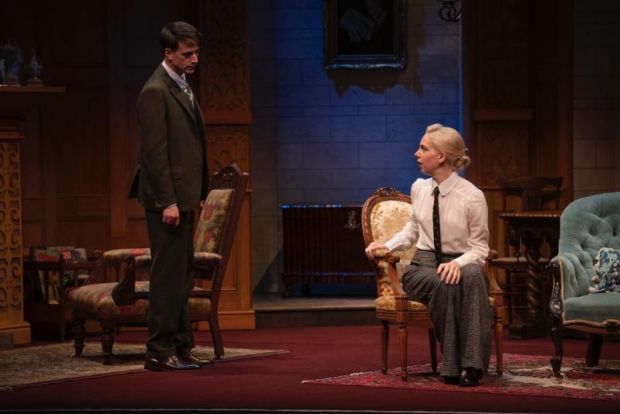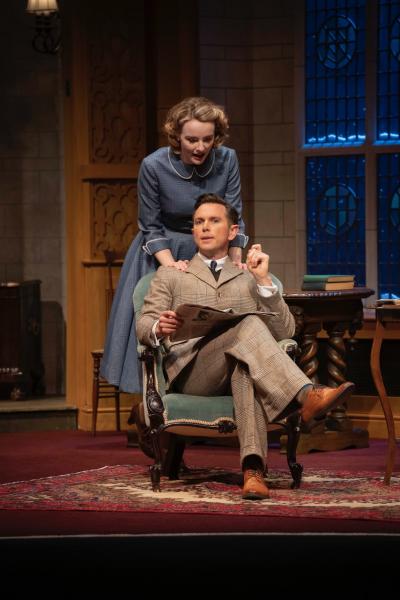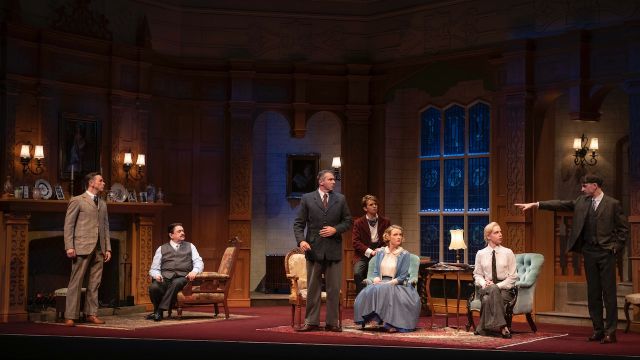Caught in the Trap
Coral Drouyn explores the “Whodunit” of The Mousetrap, speaking to Anna O’Byrne, at the start of its Australian national tour.
I Confess! Guilty as charged. I did it and it’s criminal! And I am a serial offender, so lock me up and throw away the key. Yes, for over twenty years in my youth, I looked at the last two pages of every Agatha Christie murder mystery BEFORE I read the book. Then, knowing in advance who the killer was, I would read the book and try to figure out if the story had any loopholes. I was always more interested in the journey than the destination; in the “why?” and “how?” rather than the “who?” and “what?” In other words, I was a wowser from a very young age.
But now, my crimes have come back to haunt me. Agatha Christie’s iconic play The Mousetrap is opening in Australia next month and – I HAVEN’T READ THE BOOK. I have no idea who the murderer is and, since the audience is sworn to secrecy NOT to reveal the ending, I must sit in a darkened theatre for two hours+ trying to figure out “whodunit”. It’s a suitable punishment for my sins, but an absolute delight for the rest of us theatregoers that the world’s longest running play is gracing our stages again.
Agatha Christie originally wrote the story as a short radio play entitled Three Blind Mice, which was broadcast in 1947 as a birthday present for Queen Mary. She eventually adapted the work into a short story before again rewriting it for the stage as The Mousetrap. The plot was typical Christie, described thus:-
“After a local woman is murdered, the guests and staff at Monkswell Manor (a guest house…or B&B as we would call it) find themselves stranded during a snowstorm. It soon becomes clear that the killer is among them, and the seven strangers grow increasingly suspicious of one another. A police detective, arriving on skis, interrogates the suspects: the newlyweds running the house; a spinster with a curious background; an architect who seems better equipped to be a chef; a retired Army major; a strange little man who claims his car has overturned in a drift; and a jurist who makes life miserable for everyone. When a second murder takes place, tensions and fears escalate. This record-breaking murder mystery features a brilliant surprise finish from the foremost mystery writer of all time.” It was an instant smash hit.

For 70 years, Agatha Christie’s The Mousetrap has kept millions of people from every part of the world entertained, and tourists queue to be photographed at the moving calendar which denotes each performance … making that audience part of the history of the world’s longest running show.
But not everyone was a fan. One cheeky London cabbie, when dropping people who did not give him a tip at the theatre, would yell out “The Butler did it” as a spoiler. Bewildered audience members would wait all night for the mythical butler to appear. But that didn’t deter audiences. At one stage the play was the Number 2 tourist attraction in London - right behind The Royal Family. In fact, in 2002 the Queen attended the 50th Anniversary performance (where she cut the birthday cake with a ceremonial sword), so tourists could have killed two birds with one stone. Christie would have liked that.
It seems unimaginable that the play, which opened in the West End on October 6th, 1952 (the year Elizabeth II became Queen) has racked up over 28,500 performances so far. The current West End cast were not even born when the curtain rose on the first performance. And though Christie was (and still is) the best-selling novelist of all time, the producers weren’t certain that Christie’s play would excite theatre-goers, so they loaded the cast with theatre royalty in the form of Richard Attenborough and his wife Sheila Sim - who had successful film careers on British screens and were household names.
Attenborough was contracted to the famous Boulting Brothers, who had their own film studios, and - quite by chance (ahem!) - the original production was directed by their older brother Peter Cotes. It seems the Boulting Brothers hoped to make the film with Attenborough repeating his stage role. So certain was Christie that the play wouldn’t have longevity that she insisted the play not be made into a film until six months after the West End run had finished, in order to maximise theatre audiences - which means that somewhere in that great film studio in the sky, an entire crew is still sitting around waiting for Roy Boulting to call “Lights, Camera, Action.”

But if the West End has Royal connections with the play, the Australian production is just as impressive. Our “Queen of Drama”, the multi award winning Robyn Nevin, is directing. Since 1959, when she was part of the very first intake at NIDA at the age of only 16, Robyn has had a profound effect on both stage and screen, and surely has earned the title of Theatre Royalty. She has certainly cast the play with some very special actors. We have our own beloved Queen in the form of Gerry Connolly, best known to TV viewers for his uncanny impersonations of Her Majesty. Though Connolly is best known in some quarters for his comedy, he’s also a gifted actor and a sheer delight on stage. Then there is our “Dowager Duchess” of Musical Theatre, the amazing Geraldine Turner, one of Stephen Sondheim’s favourite leading ladies, who has graced our stages for more than 30 years. Making her professional stage debut is Charlotte Friels. If the name sounds familiar, it should be. Charlotte is the daughter of the revered Judy Davis and our favourite leading man, Colin Friels. To date, Charlotte has been seen in NITRAM, a film starring her iconic mother, but watch out. She has a theatre pedigree to die for.
At the head of the cast is the Crown Princess of Musical Theatre, Anna O’Byrne. O’Byrne’s singing voice has made her an international star and Andrew Lloyd Webber’s choice for the lead in both the Australian stage production and the film of Love Never Dies. I was lucky enough to catch up with her for a quick chat and asked her about the differences between West End and Australian audiences.
“English audiences are perhaps a little more reserved,” Anna tells me, “but the difference is most notable at the stage door - so many accents and dialects. The audience is so diverse, so multicultural, in London - which is odd because we have such a multi-cultural community in Australia, but not so much when it comes to going to the theatre.”

Once again Anna is playing a lead in a period piece rather than a contemporary one, but she doesn’t mind one bit.
“I think perhaps I have ‘the look’ for period pieces,” she explains. “I have loved exploring the Edwardian and Victorian eras, but the1950s is something totally different,” she continues, “with Britain finding itself after World War II, which is almost inconceivable to my generation. It really was the dawn of the Modern Age, and I don’t think that humanity has quite got its head around that yet. It feels like so long ago, but actually it’s less than a lifespan.”
And the whole setting of a Victorian guest-house, and the unlikely premise of being trapped inside with a killer?
Anna laughs.
“It’s wonderfully escapist and, in its own way, it pokes fun at the idea of tea and cucumber sandwiches in a country where there was still food rationing and the aftermath of war. The British ‘keeping up appearances’.”

Anna has left the West End behind for a safer post-pandemic location in Geelong, where she and partner Andy Conaghan (currently on stage in Harry Potter in Melbourne) are raising their two-year-old son, while Anna has been keeping her voice in shape by giving singing lessons.
“It’s very different doing a non-singing role. Actors have to take care of their voices, but it’s a different routine, different muscles, for singers, and I just hope I’m up to eight performances a week,” she says.
Given my own sins reading Agatha Christie, I ask about her own experiences with the books, and she seems a little embarrassed.
“You know, I have never actually read an Agatha Christie novel,” she confesses. “I’ve seen films and TV shows of course, but never read a book. I’m about to start with The Murder of Roger Akroyd.”
So, did she turn to the last pages of the script for The Mousetrap to find out who did it?
“No!” she adamantly breaks in. “We didn’t get the complete script at first, and I had no idea who the murderer was. I mean, what if it turned out to be me?”
Anna will be joined by Alex Rathgeber – another of our favourite leading men, the versatile Adam Murphy, Laurence Boxhall, and the current Prince of Belvoir, Tom Conroy. It’s a cast worthy of any production. And it opens almost 70 years to the day since the curtain first rose on this classic thriller.
The Mousetrap began its Australian tour at Sydney’s Theatre Royal in October, with seasons at QPAC’s Playhouse in November, then Her Majesty's Theatre, Adelaide in December and Melbourne’s Comedy Theatre in February to follow.
For more details visit.
Images from the Australian production. Photographer: Brian Geach
Subscribe to our E-Newsletter, buy our latest print edition or find a Performing Arts book at Book Nook.

